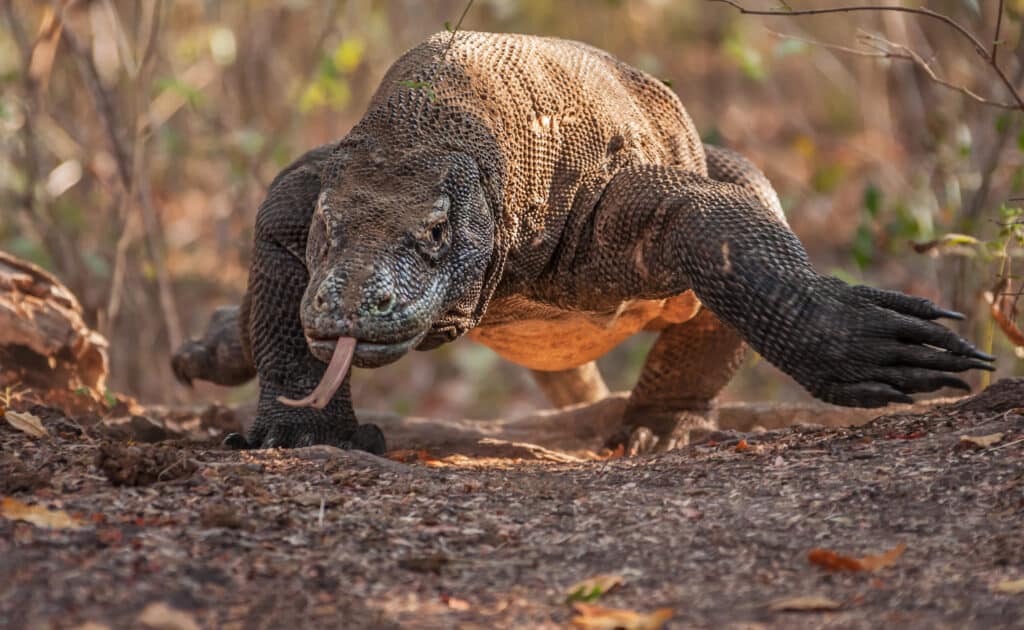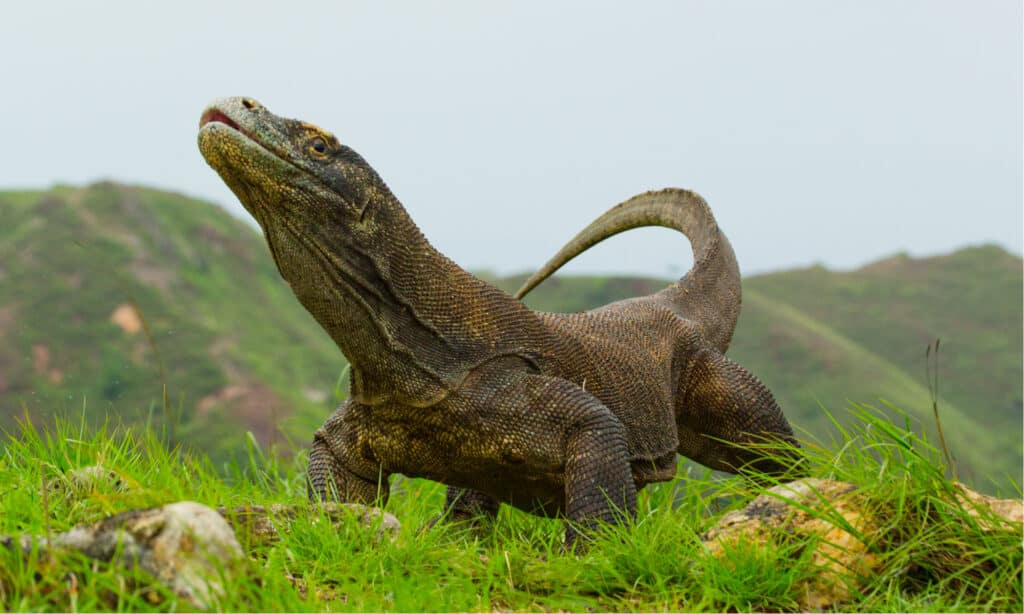If you’ve ever seen a Komodo dragon, you know that these huge lizards are pretty intimidating! But did you know they can also be incredibly fast? So, just how fast can these lizards run? Keep reading to find out!
How Fast Can Komodo Dragons Huge Lizards Run?

©Sergey Uryadnikov/Shutterstock.com
Komodo dragons have the ability to reach speeds of up to 13 miles per hour when running. That might not sound like much compared to other animals, but it’s actually quite impressive for such large yet stout creatures. Not only do they have great speed and agility when chasing their prey, but they also use their long tongues and sharp claws as weapons in order to catch them quickly.
How Does The Komodo Dragon’s Speed Compare To Other Animals?
Komodo dragons’ speed is relatively fast for a 10-foot-long and 330-pound lizard, but it is not as fast as other animals like lions, which can run up to 50 miles per hour. The Komodo dragon’s hunting strategy is based on stealth and power rather than speed. They are sprinters, not marathon runners, using their speed to ambush and bite their prey rather than chase it down.
How Does The Komodo Dragon’s Speed Compare To Other Lizards?

©iStock.com/kiwisoul
Komodo dragons are one of the fastest lizards. However, there are other lizards that are faster than Komodo dragons, such as the spiny-tailed iguana, which can run up to 21 miles per hour (34 kilometers per hour).
How Does The Komodo Dragon’s Speed Help It Hunt?
The Komodo dragon’s speed helps it hunt by allowing it to quickly ambush and bite its prey. They can run up to 13 miles per hour (21 kilometers per hour) for short distances. Unlike humans, the Komodo dragon does not need as much time to speed up in order to strike, which is part of the reason why it is such a dangerous predator. The Komodo dragon’s hunting strategy is based on stealth and strength, not just speed, and they will suddenly charge at the animal while pursuing them and go for the kill.
How Does The Komodo Dragon Ambush Its Prey?
The Komodo dragon waits patiently in tall grasses or bushes until prey passes by before ambushing it. They are skilled predators and frequently ambush live victims by charging in unexpectedly and quickly. The Komodo dragon can stand up on its back legs and use its tail as support to catch out-of-reach prey. The Komodo dragon will charge the prey without warning and attack it once it gets close to the dragon’s ambush location.
How Many Komodo Dragons Are Left In The World?

©GUDKOV ANDREY/Shutterstock.com
The number of Komodo dragons left in the wild is estimated to be around 1,380 adult Komodo dragons and 2,000 juveniles. The International Union for Conservation of Nature (IUCN) has reclassified the Komodo dragon as an “endangered” species. Despite their endangered status, their small number is relatively stable, thanks to conservation efforts. The majority of the Komodo dragon population is found on Komodo Island and Rinca Island.
Why Are Komodo Dragons Endangered?
Due to habitat degradation brought on by humans, illicit hunting, and climate change, Komodo dragons are in danger. The population of the current species is also threatened by human poaching, habitat loss, and a scarcity of egg-laying females. Within the next 45 years, it is anticipated that the ancient lizard’s habitat in Komodo National Park will be reduced by more than 30% due to rising sea levels and temperatures. The only area in the world where the enormous lizards are seen in the wild is in a national park in Indonesia, where the government has raised admission prices to view the endangered Komodo dragons.
How Can We Protect The Komodo Dragon Population?
To protect the Komodo dragon population, there is a vital need for island-based conservation strategies to manage the Komodo dragon population in their current distribution areas. The Komodo National Park was created 40 years ago to preserve the dragons from many threats, particularly those brought on by human activities.
Limiting human interactions with the Komodo dragons is also important, as tourists can get quite close to the lizards, leading to changes in their behavior. Stronger conservation efforts are still needed, and research needs to be carried out to understand them better. Joining conservation initiatives and participating in the Komodo Dragon Conservation program can also help protect the species.
In Conclusion
It’s amazing how adaptable these reptiles are despite their size. They can move surprisingly quickly over short distances in order to hunt or escape danger from predators like tigers and bears. Plus, with some practice (and maybe a few treats) it is possible for humans to learn how to interact with Komodo dragons so that we may observe them safely and help them thrive without worrying about getting eaten alive!
So next time you see one of these ancient giants lumbering around its habitat remember just how capable they really are – even if all we get out of the experience is an appreciation for this incredible creature’s speed!
The post Komodo Dragon Speed: How Fast Can These Huge Lizards Run? appeared first on AZ Animals.
from Animal News, Facts, Rankings, and More! - AZ Animals https://ift.tt/3QhAUnG